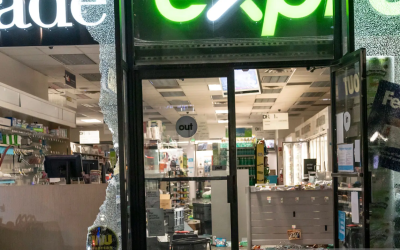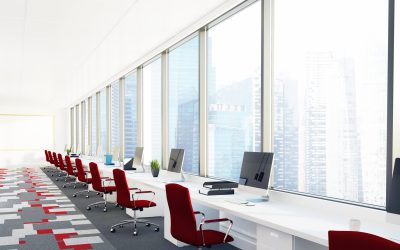Low-emittance (or Low-E) windows are quickly becoming the standard for energy efficiency in today’s homes and buildings. Low-E glass helps reduce energy costs and harmful ultraviolet (UV) rays while allowing plenty of natural light. But can window film make Low-E windows even better? The answer is yes!
Keep reading to learn what Low-E windows are, how they work, and why our window film is an ideal solution for Low-E window problems – adding many benefits that turn your windows into a powerhouse of protection.
What Are Low-E Windows?
Emissivity measures a material’s ability to radiate energy, and Low-E stands for low emissivity. Low-E windows have a thin, colourless metallic coating applied to the window’s surface to improve energy efficiency. When we say thin, we mean very thin – even thinner than a human hair. Low-E glass coatings are applied to minimize the amount of longwave infrared light (or heat) radiating through a window, improving its insulation properties. Radiating energy loss is a leading cause of heat transfer through all windows.
There are two types of Low-E glass coatings:
- Passive Low-E coating maximizes solar heat gain into a home or building to create the effect of “passive” heating, reducing the need for artificial heating sources (such as furnaces, heat pumps, space heaters, etc.).
- Solar control Low-E coating limits the amount of solar heat that passes into a home or building to keep the interior cooler, reducing energy consumption related to air conditioning, fans, and other cooling methods.
Benefits of Low-E Windows
Reduces Energy Costs More Than Clear Glass
Low-E glass is more expensive than regular glass but can save a great deal of money on utility bills, making it an investment that pays off over time. Low-E windows can help save money on heating costs during winter months by reducing the heat loss in your home or building.
Check out this blog to learn more about how window film can help save money.
Reduces UV Light Transmission
Low-E glass helps reduce the UV rays entering a home or building. UV rays contribute to fading of fabrics over time and can leave you sunburned after too much exposure. Reducing UV rays with Low-E windows helps save your furniture, flooring, and draperies from fading and sun damage.
We wrote extensively about the harmful effects of UV light here.
Allows in Natural Light
Low-E windows will reduce visible light slightly compared to a clear glass pane. But there should still be plenty of natural light to brighten your home or building!
How Does Window Film Help?
Applying high-performing solar control window films to Low-E windows makes a good product even better, providing you with the following:
- Superior heat reduction over Low-E windows and standard windows
- Greater than 99% UV blocking
- Increased fade protection
- Reduced glare from overly bright windows
Applying quality solar control window films to Low-E windows also helps fix many common Low-E window problems. For instance, some Low-E windows can allow too much heat to enter, allow too much visible light (creating glare), or only block a portion of UV light. It’s easy to solve these issues by applying a quality window film, which can reduce 86% of the sun’s heat and blocks over 99% of damaging UV rays.
Weighing the Pros and Cons of Window Film
Whether you should consider tinting Low-E windows and how much you would benefit comes down to three factors: the type of Low-E coating, the location of the Low-E coating within the window, and the amount of solar heat gain reduction or heat loss reduction desired.
Type of Low-E Surface
There are two types of Low-E coatings on glass. The first type is a conductive coating put on the glass as it’s being made. It reduces heat loss but does very little to reduce heat gain in a home or building. We refer to this as a hard coat Low-E.
The second type is a more complex system of multiple layers of metals and conductive coatings deposited on the glass after it’s made. This type of Low-E glass provides 30-50% heat gain reductions in addition to reducing heat loss. We call this a soft coat Low-E.
Location of the Low-E Surface
Typical windows are double-pane insulating units (IGU). There are four potential surfaces (lites) on which Low-E coatings are used: the first (#1) surface faces outside, the second (#2) and third (#3) surfaces face each other within the IGU and are separated by a spacer (creating an insulating space), and the fourth (#4) surface faces directly inside. Passive Low-E coatings function best on the third or fourth surface, which is furthest from the sun. Solar control Low-E coatings function best on the lite that is closest to the sun, which is usually the second surface.
Choosing the Right Film
Choosing the best solar control window film depends on the desired amount of solar heat gain or heat loss reduction. We offer many shades and colours of film, all designed to perfect your windows. From silver to bronze to grey, these films enhance existing windows to make your home or building more comfortable by reducing glare, blocking UV light, and offering superior heat reduction over Low-E windows and standard windows alone.
Get the Glass Specifics
When in doubt, ask the glass company or window manufacturer to send specific information about the Low-E glass in question so we can help you make the best decision. We are here to help, too! Contact us today!
Partner With Hi-Calibre Views Today
Hi-Calibre Views partners with manufacturers who have set the standard for producing world-class, high-quality film products. Our manufacturing partners are the world’s leading window film manufacturers, providing specialty solutions for the automotive, architectural, healthcare, aerospace, and transportation industries.



